NCERT Solutions for Class 11 Biology Chapter 8 Cell: The Unit of Life
These Solutions are part of NCERT Solutions for Class 11 Biology. Here we have given NCERT Solutions for Class 11 Biology Chapter 8 Cell: The Unit of Life.
Question 1.
Which of the following is not correct?
(a) Robert brown discovered the cell.
(b) Schleiden and Schwann formulated the cell theory.
(c) Virchow explained that cells are from pre¬existing cells.
(d) A unicellular organism carries out its life activities within single cell.
Solution:
(a) Robert brown discovered the cell.
Question 2.
New cells generate from
(a) bacterial fermentation
(b) regeneration of old cells
(c) pre-existing cells
(d) abiotic material
Solution:
(c) pre-existing cells
Question 3.
Match the following
Column A Column B
(a) Cristae (i) Flat membranous sac in stroma
(b) Cisternae (ii) Infoldings in mitochondria
(c) Thylakoids (iii) Disc-shaped sacs in Golgi apparatus
Solution:
(a) Cristae (ii) Infoldings in mitochondria
(b) Cisternae (iii) Disc-shaped sacs in Golgi apparatus
(c) Thylakoids (i) Flat membranous sac in stroma
Question 4.
Which of the following is correct
(a) Cells of living organisms have a nucleus.
(b) Both animals and plant cells have a well defined cell wall.
(c) In prokaryotes, there are no membrane bound organelles.
(d) Cells are formed de novo from abiotic materials
Solution:
(c) In prokaryotes, there are no membrane-bound organelles.
Question 5.
What are mesosomes in a prokaryotic cells? Mention the function that it performs.
Solution:
A special membranous structure is a mesosome that is formed by the extensions of the plasma membrane into the cell. These extensions are in the form of vesicles, tubules, and lamellae. They help in cell wall formation, DNA replication, and distribution to daughter cells. They also help in respiration, in the secretion process increase plasma membrane surface and enzymatic content.
Question 6.
How do neutral solutes move across the plasma membrane? Can the polar molecules also move across it in the same way? If not, then how are these transported across the membrane?
Solution:
Neutral solutes may move across the membrane by the process of simple diffusion along the concentration gradient i.e. from higher concentration to the lower. Water may also move across this membrane from higher to lower concentrations. The movement of water by diffusion is called osmosis. As the polar molecules cannot pass through the non-polar lipid bilayer, they require a carrier protein of the membrane to facilitate their transport across the membrane.
A few ions or molecules are transported across the membrane against their concentration gradient i.e. from lower to the higher concentration. Such transport is an energy-dependent process, in which ATP is utilized and is called active transport. e,g., Na’/K* Pump.
Question 7.
Name two cell-organelles that are double membrane-bound. What are the characteristics of these two organelles? State their functions and draw labelled diagrams of both.
Solution:
Two double membrane-bound cell organelles:
(a) Mitochondria: It has finger-like folds in the inner membrane called cristae. Mitochondria is the place for aerobic respiration.
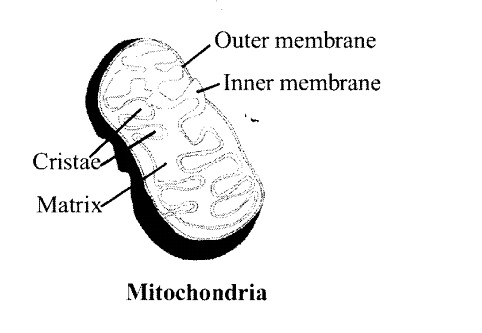
(b) Chloroplast: Chloroplast is responsible for converting light energy into chemical energy. Chloroplast contains stacked thylakoid in its matrix.
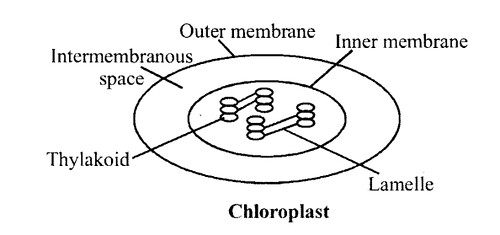
Functions of mitochondria: The double membrane mitochondria are actively associated with aerobic respiration and the release of energy for cellular activity. The biological oxidation of the fats and carbohydrate release much amount of energy which is utilised by mitochondria for ATP synthesis. The required energy is released from ATP molecules for various cell processes in cells so they are termed as “the powerhouse of the cell”
Functions of chloroplast :
(i) Their main function of the chloroplast is to trap the sun’s energy and to convert it into chemical energy of food by photosynthesis.
(ii) Storage of starch.
(iii) Chloroplast in fruits and flowers changes into chromoplasts.
Question 8.
What are the characteristics of prokaryotic cells?
Solution:
The prokaryotic cells are represented by bacteria, blue-green algae, mycoplasma, and PPLO (Pleuro Pneumonia-like organisms). They are generally smaller and multiply more rapidly than the eukaryotic cells. They may vary greatly in shape and size. The four basic shapes of bacteria are bacillus (rod-like), coccus (spherical), vibrio (comma-shaped), and spirillum (spiral).
The organization of the prokaryotic cell is fundamentally similar even though prokaryotes exhibit a wide variety of shapes and functions. All prokaryotes have a cell wall surrounding the cell membrane. The fluid matrix filling the cell is the cytoplasm. There is no well-defined nucleus. The genetic material is basically naked being not enveloped by a nuclear membrane.
In addition to the genomic DNA (the single chromosome/ DNA circle), many bacteria have small DNA circles outside the genomic DNA. These smaller DNA circles are called plasmids, The plasmid DNA confers certain unique phenotypic to antibiotics. Prokaryotes have something unique in the form of inclusions.
A specialised differentiated form of the cell membrane called mesosome is the characteristic of prokaryotes. They are essentially infoldings of the cell membrane.
Question 9.
Multicellular organisms have a division of labour. Explain.
Solution:
In unicellular organisms, there is no division of labour.
- The single cell of the organisms is capable of performing all the vital activities of life i.e., respiration, movement, digestion and reproduction, etc. Respiration, nutrition, and excretion in most of these unicellular organisms takes place through the general body surface.
- No special organs for these are present in them because they are too small to need them. Most of these unicellular organisms reproduce by simple binary division, to maintain their continuity.
- However, in some, sexual reproduction has also been observed.
Question 10.
Cell is the basic unit of life. Discuss in brief.
Solution:
Cell: The Basic Unit of life: All living organisms are composed of small, tiny structures or compartments called cells. These cells are called the ‘building blocks’ of life.
- The cells in true sense are considered as the basic unit of life because all the life processes i.e., metabolism, responsiveness, reproduction are carried out by the cells.
- Respiration, nutrition, release of energy for the body are carried out within the cells only.
- Even the animals and plants reproduce because the cells reproduce individually.
- Growth occurs because cell grow and multiply.
In Amoeba all the life processes are performed within the boundaries of the single cell. - This is true of all other multicellular organisms. The only difference in the multicellular organisms is that the body of these organisms is made up of many cells.
- In these organisms, the cell do not behave independently but get organized into tissues. Each tissue is specialized to perform specific functions. Different tissues then get organised into tissues.
- Each tissue is specialized to perform specific functions. Different tissues then get organised into organs which perform certain specific functions.
- Different organs are finally organised to form organ systems. Now it must be very clear that the basic structure to tissues, organs and organ system are the cells only.
- These tissues, organs and organ system of the organisms work because the cells work.
- Thus “the cells are structural and functional unit of the living beings” hence it is the basic unit of life.
Question 11.
What are nuclear pores? State their function.
Solution:
At a number of places, the nuclear envelope is intercepted by minute pores which are called nuclear pores. These are formed by the fusion of two nuclear membranes. These nuclear pores are the passages through which the movement of RNA and protein molecules takes place in both directions between the nucleus and the cytoplasm.
Question 12.
Both lysosomes and vacuoles are * endomembrane structures, yet they differ in
terms of their functions. Comment.
Solution:
Lysosomes are filled with hydrolytic enzymes that are capable of digesting carbohydrates, proteins, lipids and nucleic acids whereas vacuoles contain water, sap, excretory product and other materials not useful for cell.
Question 13.
Describe the structure of the following with the help of labelled diagrams.
(i) Nucleus
(ii) Centrosome
Solution:
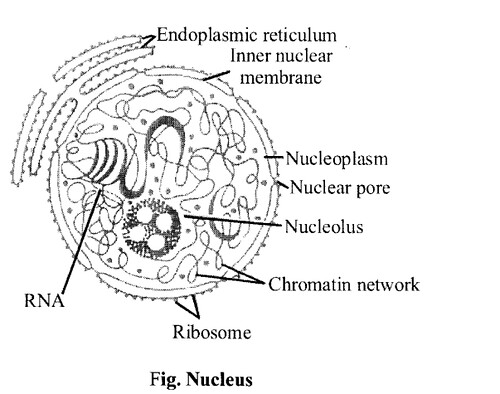
(i) Nucleus:
-
- The nucleus is a large organelle controlling all the activities of the eukaryotic cells. Some cells have more than one nucleus.
- Binucleate cells have 2 nuclei per cell eg. Paramoecium. Multinucleate cells have many nuclei e.g. Ascaris.
- Some cells lack nucleus (anucleate) at maturity. Examples: mammalian RBCs and sieve tube cells in vascular plants.
- The nucleus is bounded by two membranes, which make the nuclear envelope.
- The outer and inner membranes are separated by a narrow space, perinuclear space.
- The outer membrane remains in continuation with endoplasmic reticulum (ER) and the inner one surrounds the nuclear contents.
- At some points, the nuclear evelope is interrupted by the presence of small structures called nuclear pores.
- These pores help in exchange of materials between nucleoplasm and cytoplasm. Nuclear membrane dissappears during cell division. It reappears during nuclear reorganization in stage.
- The nucleoplasm contains chromatin and nucleolus. The nucleolus is a rounded structure. It is not separated from the rest of the nucleoplasm by membrane.
- It is associated with a specific nucleolar organizing region (NOR) of some chromosomes. Nucleolus is the “site for ribosomal RNA synthesis”.
- The cells which remain engaged in protein synthesis have larger and more numerous nuclei in their nucleoplasm.
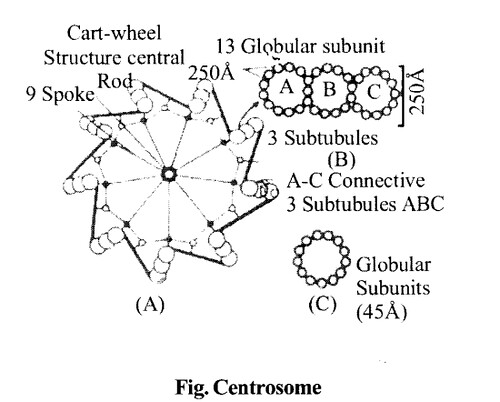
(ii) Centrosome:
- Under the electron microscope, each centriole is seen to be formed of nine sets of tubular structures arranged in a circular fashion.
- Each of these sets is a triplet composed of three microtubules. Each microtubule has a diameter of about 250A. The triplets are found in the matrix.
- Sometimes delicate strands appear to connect sets of the triplet to each other.
- Also can be seen radiating from the central core of the cylinder, delicate strands which connect sets of the triplets to each other giving a cartwheel appearance.
- Basal bodies are structures similar to the centrioles. They produce cilia and flagella.
Question 14.
What is a centromere? How does the position of the centromere form the basis of the classification of chromosomes? Support your answer with a diagram showing the position of the centromere on different types of chromosomes.
Solution:
Eukaryotic chromosomes: The chromosomes are uncoiled in a loose, indistinct network called the chromatin that contains DNA, RNA and protein in interphase.
The types of proteins present and associated with DNA are histone and non-histone proteins.
Chromosomes are thread-like structures. They become visible (under light microscope) during cell division.
In higher organisms, the well-developed nucleus contains a definite number of chromosomes of definite size and shape.
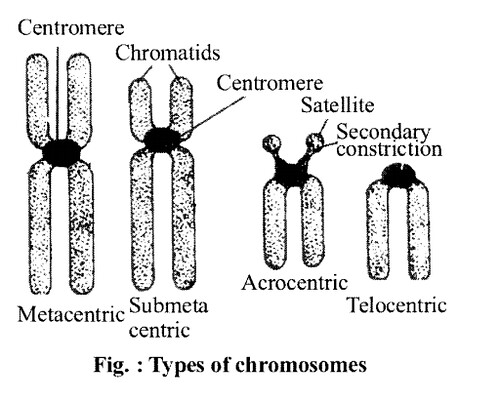
The shape of a chromosome is usually observable at metaphase and anaphase when the position of primary constriction {centromere) is clearly seen. Based on the position of the centromere, chromosomes are of 3 types:
- telocentric – with terminal centromere,
- the acrocentric – terminal centromere is capped by a telomere
- submetacentric – the centromere is subterminal in position
- metacentric – these have median centromere.
VERY SHORT ANSWER QUESTIONS
Question 1.
Who discovered the Golgi body?
Solution:
Camillo Golgi (1898).
Question 2.
Give the location of 70S ribosomes.
Solution:
Prokaryotic cells, plastids, and mitochondria
Question 3.
Name the cell organelle rich in acid hydrolases.
Solution:
Lysosomes
Question 4.
Who proposed the cell theory?
Solution:
Schleiden and Schwann.
Question 5.
Expand PPLO.
Solution:
PPLO (Pleuro Pneumonia Like Organisms)
Question 6.
Name the organelle responsible for protein synthesis in a cell.
Solution:
Ribosome
Question 7.
Give the full form of SER and RER.
Solution:
- SER – Smooth endoplasmic reticulum.
- RER – Rough endoplasmic reticulum.
Question 8.
Name the membrane which surrounds the vacuole in the cell.
Solution:
Tonoplast
Question 9.
Name two types of constituents of the plasma membrane.
Solution:
Proteins and lipids.
Question 10.
Name two processes of passive transport.
Solution:
- Osmosis
- Diffusion
Question 11.
What is plasmodesmata? What is its function?
Solution:
Plasmodesmata: Adjoining the cells and the linking gap of cytoplasmic protoplasmic presence is called Plasmodesmata. It links the neighbouring cells together.
SHORT ANSWER QUESTIONS
Question 1.
Why fluid-mosaic model is more accepted than other models of the plasma membrane?
Solution:
The fluid mosaic model explains
(i) quasifluid state of the plasma membrane,
(ii) It differentiates two 6. types of proteins
(iii) It explains functional specificity and variability in two surfaces of PM.
Question 2.
Name three types of elements in the Golgi body. List two major functions of the Golgi body.
Solution:
Three types of elements in golgi body are cistemae, vesicles and vacuoles. The main function of golgi bodies are cellular secretion and acrosome formation.
Question 3.
What is peculiar about mitochondrial DNA?
Solution:
Mitochondrial DNA is circular double-stranded and not associated with histone proteins.
Question 4.
How does cytokinesis take place in plant and animal cells?
Solution:
In plant cell cytokinesis take place by cell plate formation and in animal cells it occurs by constriction
Question 5.
Differentiate between prokaryotic and eukaryotic cells.
Solution:
The main differences between prokaryotic cell and eukaryotic cell are
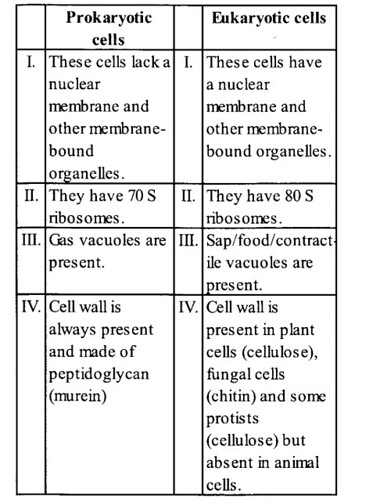
Question 6.
Differentiate between active and passive transport across the membrane.
Solution:
The main differences between active transport and passive transport are
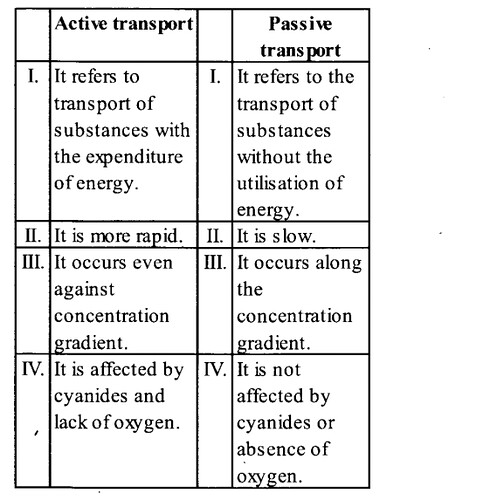
Question 7.
Describe the different methods of transport of nutrients in cell.
Solution:
Different methods of transport of nutrients in the cell are:
(i) Simple diffusion : It is the movement of ions/ molecules of any substance from a region of higher concentration to ‘the region of lower concentration, until equilibrium is reached. Many neutral solutes move by diffusion.
(ii) Osmosis : It is the movement of solvent molecules across a semipermeable membrane, from the region of higher concentration to the region of lower concentration, until equilibrium is reached. Water moves by osmosis from one cell to the other.
(iii) Facilitated diffusion : It refers to the movement of ions/molecules across the membrane with the help of transmembrane proteins.
Question 8.
Why are ribosomes of prokaryotes different from eukaryotes?
Solution:
The type of ribosomes of prokaryotes is different from eukaryotes because the prokaryotes were primitive, simpler and have remained intact during evolution while at the base level eukaryotes have adapted with the environment and are retaining their kind of entities for the complex structure. Prokaryotes have 70S ribosomes with 30S and 50S subunit and eukaryotes have 80S ribosome with 40S subunit and 60S sub unit.
Question 9.
What is the function of
(1) Nuclear Pores
(2) Slimy Capsule in Bacteria
(3) Golgi Bodies:
(4) Centrosome with Centrioles
Solution:
(1) Nuclear Pores: There is exchange of RNA and proteins through the nuclear pores
(2) Slimy Capsule in Bacteria : A slimy capsule is the outer covering of cell wall of bacteria and is an additional protection for the bacteria.
(3) Golgi Bodies :
(i) It takes part in packaging materials delivered either to the intra-cellular targets or secteted outside the cell.
(ii) It is also a important site of formation of glycoproteins and glycolipids.
(4) Centrosome with Centrioles
(i) Centrioles help in organising the spindle fibres and astral rays during cell division.
(ii) It also provides basal bodies which give rise to cilia and flagella.
LONG ANSWER QUESTIONS
Question 1.
Describe the structure of cell wall.
Solution:
- A non-living rigid structure called the cell wall forms an outer covering for the plasma membrane of fungi and plants.
- Cell wall does not only give shape to the cell and but protect the cell from mechanical damage and infection.
- It also helps in cell-to-cell interaction and provides barrier to undesirable macromolecules.
- Algae have cell wall, made of cellulose, galactans, mannans and minerals like calcium carbonate, while in other plants it consists of cehulose, hemicellulose, pectins and proteins.
- The cell wall of a young plant cell, the primary wall is capable of growth, which gradually diminishes as the cell matures and the secondary wall is formed on the inner side of the cell.
- The middle lamella is a layer mainly of calcium pectate which holds or glues the different neighbouring cells together.
- The cell wall and middle lamellae may be transferred by plasmodesmata which connect the cytoplasm of neighbouring cells.
Question 2.
Give an account of prokaryotic cells.
Solution:
- The prokaryotic cells are represented by bacteria, blue green algae, mycoplasma and PPLO (Pleuro Pneumonia Like Organisms). They are generally smaller and multiply more rapidly than the eukaryotic cells.
- They may vary greatly in shape and size. The four basic shapes of bacteria are bacillus (rod like), coccus (spherical), vibrio (comma shaped) and spirillum (Spiral).
The organisation of the prokaryotic cell is fundamentally similar even though prokaryotes exhibit a wide variety of shapes and functions. All prokaryotes have a cell wall surrounding the cell membrane. - The fluid matrix filling the cell is the cytoplasm. There is no well defined nucleus.
- The genetic material is basically naked, not enveloped by a nuclear membrane.
- In addition to the genomic DNA (the single chromosome/circular DNA), many bacteria have small circular DNA outside the genomic DNA. These smaller DNA is called plasmids.
- The plasmid DNA confers certain unique phenotypic characters to such bacteria. One such character is resistance to antibiotics. Nuclear membrane is found in eukaryotes.
- No organelles, like the ones in eukaryotes, are found in prokaryotic cells except ribosomes.
- Prokaryotes have something unique in the form of inclusions. A specialised differentiated form of cell membrane called mesosome is the characteristic of prokaryotes which helps in respiration process.
- They are essentially infoldings of cell membrane.
Question 3.
Give an ultrastructure of mitochondria.
Solution:
- Mitochondria, unless specifically stained, are not easily visible under the microscope.
- The number of mitochondria per cell is variable depending on the physiological activity of the cells.
- In terms of shape and size also, considerable degree of variability is observed.
- Typically it is sausage shaped or cylindrical having a diameter of 0.2-1.0 ft m (average 0.5 film) and length (1.0 -4.1 ft).
- Each mitochondrion is a double membrane-bound structure with the outer membrane and the inner membrane dividing its lumen distinctly into two aqueous compartments, i.e. the outer compartment and the inner compartment.
- The inner compartment is called the matrix. The outer membrane forms the continuous limiting boundary of the organehe.
- The inner membrane forms a number of infoldings called the cristae. The cristae increase the surface area.
- The two membranes have their own specific enzymes associated with the mitochondrial function. Mitochondria are the sites of aerobic respiration.
- They produce cellular energy in the form of ATP, hence they are called. “Power houses” of the cell.
- The matrix also possesses single circular DNA molecule, a few RNA molecules, ribosomes (70s) and the components required for the synthesis of proteins. The Mitochondria divide by fission.
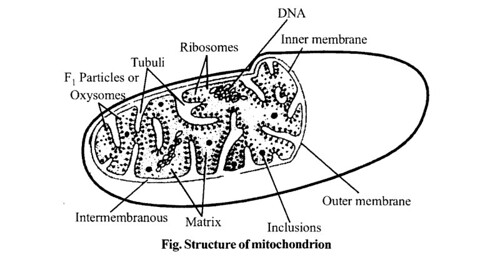
Question 4.
Describe the fluid mosaic model of membrane.
Solution:
The characteristic features of fluid mosaic model
• This model was proposed by Singer and Nicholson.
• According to this model, there is a central bilipid layer (of phospholipids) with their polar head group toward the outside and the non-polar tails pointing inwards.
• Some proteins which are embedded in the lipid layer are called integral proteins and they cannot be separated from the membrane easily.
• Some large globular integral proteins which project beyond the lipid layer on both the sides are believed to have channels through which water soluble materials can pass across.
• Those proteins which are superficially attached are called peripheral (extrinsic) proteins and they can be easily removed.
• Some membrane lipids and integral proteins remain bound to oligosaccharides; such oligosaccharides project into the extracellular fluid and they influence the manner in which cells interact with the other cell.
• There are also certain specific proteins called membrane receptors, which mediate the flow of materials and information into the cell.
Question 5.
What are plastids? How are they classified on the basis of the type of pigments? Name them and their pigments and mention their functions.
Solution:
Plastids are double-membrane bound organelles
of different shapes, that are found only in plant
cells and contain pigments and storage products.
They are of three types :
(i) Leucoplasts
These are the oval, spherical, rod-like or filamentous colourless plastids which are found in storage organs. Their main function is to store reserve materials like starch (amyloplasts), proteins (aleuroplasts) and fats (elaioplasts).
(ii) Chromoplasts
• These are coloured plastids containing mainly the yellow, red and orange pigments (carotene and xanthophyll).
• These are found in petals of flowers and skin of fruits.
• They attracts agents for pollination and dispersal of fruits/seeds.
(iii) Chloroplasts
• These are the green plastids containing mainly chlorophylls and very little carotene and xanthophyll.
• Their main function is photosynthesis and the formation of starch.
We hope the NCERT Solutions for Class 11 Biology at Work Chapter 8 Cell: The Unit of Life, help you. If you have any query regarding NCERT Solutions for Class 11 Biology at Work Chapter 8 Cell: The Unit of Life, drop a comment below and we will get back to you at the earliest.